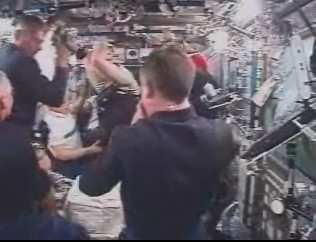First Excursion Outside ISS Deemed A Success
 ANN REALTIME UPDATE
06.11.07 2330 EDT: They're gonna fix it after all. Late
Monday night, NASA engineers determined a fourth spacewalk will be
needed during the space shuttle Atlantis' stay at the International
Space Station, so astronauts may tack down the insulating blanket
apparently blown out of place during the orbiter's launch last
week.
ANN REALTIME UPDATE
06.11.07 2330 EDT: They're gonna fix it after all. Late
Monday night, NASA engineers determined a fourth spacewalk will be
needed during the space shuttle Atlantis' stay at the International
Space Station, so astronauts may tack down the insulating blanket
apparently blown out of place during the orbiter's launch last
week.
"The better part of valor was just to go and secure [this
blanket] and not worry about it anymore," said John Shannon,
chairman of the mission management team that is overseeing
Atlantis' mission, reports the Orlando Sentinel. Engineers were
concerned the gap in the blanket -- apparently caused by air
becoming trapped under the insulation during launch -- would
expose the shuttle to potential overheating risk during
reentry.
The addition of a fourth spacewalk means Atlantis will also
remain in orbit two days longer than planned. The orbiter is now
slated to return from its mission on June 21.
About one hour ago, Mission Specialists Jim Reilly and John
"Danny: Olivas successfully completed tasks during STS-117’s
first spacewalk to activate the International Space Station’s
newest component. The 6-hour, 15-minute excursion concluded at 2217
EDT.
NASA reports Reilly and Olivas went to work after the Starboard
3 and 4 (S3/S4) truss segment was installed onto the station. They
made power, data and cooling connections between the station and
the S3/S4. The spacewalkers also released locks and launch
restraints on the segment’s solar arrays and prepared its
radiator and rotary joint for operation.
The radiator was deployed during the spacewalk. The solar arrays
will be unfurled Tuesday, and S3/S4 activation activities will
continue during STS-117’s second spacewalk, slated to take
place Wednesday afternoon.
Original Report
STS-117 and Expedition 15 crewmembers used a robotic arm Monday
morning to attach a new truss segment onto the International Space
Station, as preparations continued for the start of the first
of three planned spacewalks this week.

Robot arm operators began moving the Starboard 3 and 4 (S3/S4)
truss segment into position shortly after 1100 EDT, NASA reports,
for attachment onto the end of the station's Starboard 1 segment.
The new truss was attached at 1428 EDT.
Attachment of the truss was delayed for more than an hour
because the station's attitude control gyroscopes became saturated.
Flight controllers resolved what NASA termed a "common" issue --
with a little help from the docked shuttle, according to The
Houston Chronicle -- and installation resumed.
It remains unclear what impact, if any, the gyro-related delay
with have on the planned spacewalk by Jim Reilly and John "Danny"
Olivas to begin activation of the S3/S4. During a 6.5-hour
spacewalk, scheduled for Monday evening Eastern time, the duo will
make power, data and cooling connections between the station and
the S3/S4, which contains a new set of solar arrays.

Reilly and Olivas will also release locks and launch restraints
on the segment's solar arrays and rotary joint, in anticipation of
the array's unfolding later this week.
Elsewhere on the station, astronaut Sunita Williams formally
traded places on the ISS crew with new Expedition 15 crewmember
Clayton Anderson, with the swapping of each other's contoured seat
frames onboard the Soyuz capsule now berthed at the ISS. Williams
will return to Earth aboard Atlantis.
In a candid moment with ground controllers in Houston, Anderson
was asked how he was adjusting to life onboard the ISS. "Aside from
the fact that I don't know where anything is or how to do anything,
I'm OK," he said.
NASA has warned spacewalkers to keep a careful eye on the gloves
they use during their spacewalks, due to a small tear found in the
outermost layer of one of astronaut Robert Curbeam's gloves months
after he returned to earth onboard Discovery last December.
"If we do have damage to the glove, it will help us detect where
on the vehicle we have a sharp edge," Kirk Shireman, deputy program
manager of the ISS, told the Chronicle.
NASA continues to examine photos of a peeled-back thermal
blanket (shown below) atop Atlantis' port orbital maneuvering
system (OMS) pod. Though the agency believes the graphite and
aluminum skin below will be able to withstand the roughly
700-degree temperatures the area sees during reentry, engineers are
concerned additional heating from the blanket's protrusion could
raise the thermal threshold above acceptable levels.

The concern isn't burn-through, per se... but rather increased
temperatures would cause damage requiring extensive repairs once
Atlantis is back on the ground.
 Unfortunate... ANN/SportPlane Resource Guide Adds To Cautionary Advisories
Unfortunate... ANN/SportPlane Resource Guide Adds To Cautionary Advisories ANN FAQ: Turn On Post Notifications
ANN FAQ: Turn On Post Notifications ANN's Daily Aero-Term (04.29.24): Visual Approach Slope Indicator (VASI)
ANN's Daily Aero-Term (04.29.24): Visual Approach Slope Indicator (VASI) ANN's Daily Aero-Term (04.28.24): Airport Marking Aids
ANN's Daily Aero-Term (04.28.24): Airport Marking Aids ANN's Daily Aero-Linx (04.28.24)
ANN's Daily Aero-Linx (04.28.24)






